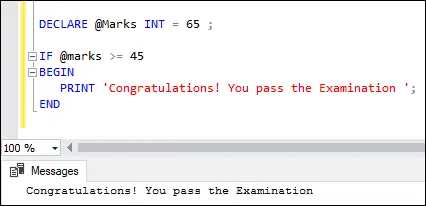Наредба ИФ је део функције тока контроле у СКЛ Серверу. Обично је то изјава за доношење одлука у различитим програмским језицима која враћа вредност на основу датих услова . Ова наредба извршава код написан у блоку ИФ када се дати услов процени као тачан, а када услов процењује нетачно, тада ће се извршити ЕЛСЕ изјава.
Изјава ИФ
Следеће је синтакса која илуструје употребу ове изјаве у СКЛ Серверу:
IF boolean_expression BEGIN { statement_block } END У горњој синтакси, тхе статемент_блоцк у ПОЧНИ...КРАЈ блок се извршава када се боолеан_екпрессион је задовољан стањем. У супротном, овај блок се прескаче, а програмска контрола се премешта у наредбу после КРАЈ кључна реч. Требало би да знамо да ако израз садржи а СЕЛЕЦТ изјаву, морамо ставите их у заграде .
Пример
Хајде да видимо пример да бисмо разумели наредбу ИФ без ЕЛСЕ блока. Пример у наставку ће приказати резултат када је услов задовољен. У супротном, програмска контрола се премешта у наредбу после кључне речи ЕНД, ако постоји.
DECLARE @Marks INT = 65 ; IF @marks >= 45 BEGIN PRINT 'Congratulations! You pass the Examination'; END
Извршавање наредбе ће дати следећи излаз:

Сада ћемо то показати на доле ' Ученик' табела која садржи следеће податке:

У наставку је још један пример који добија укупне оцене изабраног ученика из ' Ученик' табелу у бази података узорка, а затим штампа а порука ако је већи од 400 .
BEGIN DECLARE @Total_Marks INT; SELECT @Total_Marks = total_marks FROM Student WHERE age>25; SELECT @Total_Marks; IF @Total_Marks > 400 BEGIN PRINT 'Congratulations! You pass the Examination'; END END
Добићемо доњи излаз:

Ако желимо да видимо горњу излазну поруку, треба да кликнемо на Поруке картица:

Изјава ИФ-ЕЛСЕ
У стварном сценарију, морамо да извршимо неку радњу кад год је услов у изјави ИФ ТРУЕ или ФАЛСЕ. У овом случају, наредба ИФ…ЕЛСЕ је корисна. Овај израз извршава блок наредбе ЕЛСЕ када је услов у ИФ клаузули процењен ФАЛСЕ.
Следеће је синтакса која илуструје употребу израза ИФ ЕЛСЕ у СКЛ Серверу :
IF expression BEGIN Statement block -- It executes when the IF clause expression is TRUE. END ELSE BEGIN Statement block -- It executes when the IF clause expression is FALSE. END
Пример
Погледајмо пример да бисмо разумели наредбу ИФ са блоком ЕЛСЕ. Пример испод ће приказати поруку ' Честитам! Положио си испит ' када је услов ИФ задовољен. У супротном, прикажи ' Пропали сте! Више среће други пут '.
DECLARE @Marks INT; SET @Marks = 65; IF @marks <45 begin print 'congratulations! you pass the examination'; end else 'you are failed! better luck next time'; < pre> <p>Executing the statement will give the below output. Here, the <strong>marks</strong> variable is <strong>65</strong> , and the <strong>condition (65<45)< strong> is not satisfied. Therefore, the message inside the ELSE block is displayed:</45)<></strong></p> <img src="//techcodeview.com/img/sql-server-tutorials/49/sql-server-if-else-5.webp" alt="SQL Server IF ELSE"> <p>We will get this output because the condition <strong>(65>45)</strong> is satisfied. Therefore, the message inside the IF block is displayed:</p> <img src="//techcodeview.com/img/sql-server-tutorials/49/sql-server-if-else-6.webp" alt="SQL Server IF ELSE"> <p>Now, we will demonstrate the IF ELSE statement on the above ' <strong>Student'</strong> table. In this example, we are going to check whether the student <strong>total marks</strong> is <strong>greater than or equal to 400</strong> or not as follows:</p> <ul> <li>When the IF condition is TRUE, we will get the student records whose total marks are greater than or equal to 550.</li> <li>If the condition is FALSE, we will get the student records whose total marks are less than 550.</li> </ul> <p>Here is the program:</p> <pre> DECLARE @Marks INT; SET @Marks = 600 ; IF @Marks >= 550 BEGIN SELECT id, name, gender, age, total_marks FROM Student WHERE total_marks >= 550 ORDER BY age ASC END ELSE BEGIN SELECT id, name, gender, age, total_marks FROM Student WHERE total_marks <550 order by age asc end < pre> <p>In this code, we have specified the <strong>@Marks</strong> variable to <strong>600</strong> , and the condition (600 >= 550) is satisfied. Therefore, we will get the output where student records whose total marks are greater than or equal to 550 are displayed.</p> <img src="//techcodeview.com/img/sql-server-tutorials/49/sql-server-if-else-7.webp" alt="SQL Server IF ELSE"> <p>If we changed the <strong>@Marks</strong> variable to <strong>500</strong> and the condition (500 >= 550) becomes false. Therefore, we will get the output where student records whose total marks are less than 550 are displayed.</p> <img src="//techcodeview.com/img/sql-server-tutorials/49/sql-server-if-else-8.webp" alt="SQL Server IF ELSE"> <h2>Nested IF ELSE Statement</h2> <p>Unlike other programming languages, we can nest an IF...ELSE statement inside another IF...ELSE statement in SQL Server. Let us demonstrate it with the following example:</p> <pre> DECLARE @age INT; SET @age = 6; IF @age <18 50 print 'you are underage'; else begin if @age < below 50'; senior cetizen'; end; pre> <p>In this example, we are going to check whether the <strong>age is underage, below 50, or senior citizen</strong> as follows:</p> <ul> <li>If the value of the <strong>@age</strong> variable is below <strong>18</strong> , it will print the person is <strong>underage</strong> .</li> <li>If the condition is FALSE, the ELSE part will be executed that has a nested IF…ELSE.</li> <li>If the value of the <strong>@age</strong> variable is under <strong>50</strong> , it will print <strong>below 50</strong> . Finally, if no condition is satisfied, it will print <strong>senior citizens</strong> .</li> </ul> <p>Here is the result:</p> <img src="//techcodeview.com/img/sql-server-tutorials/49/sql-server-if-else-9.webp" alt="SQL Server IF ELSE"> <p>This article gives a complete overview of how to use the SQL Server IF ELSE statement. Here we have learned:</p> <ul> <li>Variables are objects that serve as placeholders.</li> <li>The keyword BEGIN will be used to start a statement block, and the END keyword must be used to close it.</li> <li>The use of ELSE in an IF... ELSE statement is optional.</li> <li>It's also possible to nest an IF...ELSE statement inside another IF...ELSE statement. However, nesting an IF statement within another statement is bad practice because it makes the code difficult to read and maintain.</li> </ul> <hr></18></pre></550></pre></45>
